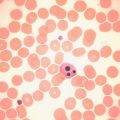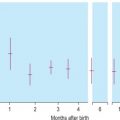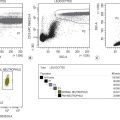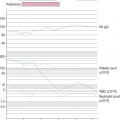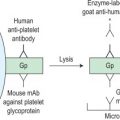Chapter Outline
Cobalamin absorption and metabolism 188
Folate absorption and metabolism 191
Haematological features of megaloblastic anaemia 193
Differential diagnosis of macrocytic anaemia 194
Metabolic insufficiency 194
Testing strategy for suspected cobalamin or folate deficiency 194
Utility of serum vitamin B 12 assays 194
Sensitivity and specificity of cobalamin assays 198
Clinical and diagnostic pitfalls of folate assays 199
Standards, accuracy and precision of cobalamin and folate assays 200
Genetic factors 200
Pre-analytical sample preparation 201
Analytical factors 201
Post-analytical factors 201
Methods for cobalamin and folate analysis 201
General principles of competitive protein-binding assays 201
Serum B 12 assays 201
Release from endogenous binders and conversion of analyte to appropriate form 201
Binding of B 12 to kit binder 202
Separation of bound and unbound B 12 202
Signal generation 202
Holotranscobalamin assays 202
Principle 202
Holotranscobalamin ‘active B 12 ’ immunoassay 203
Holotranscobalamin radioimmunoassay 203
Quantification of transcobalamin saturation 203
Serum folate methods 203
Release from endogenous binders 203
Binding of folate to folate-binding protein 203
Separation of bound and unbound folate 204
Signal generation 204
Red cell folate methods 204
Manual haemolysate preparation 204
Calculation of red blood cell folate from haemolysate folate result 204
Serum vitamin B 12 and folate and red cell folate assay calibration 205
Whole blood folate standards 205
Primary instrument calibration 205
Internal adjustment calibration 205
Internal quality control 205
Direct measurement of 5-methyltetrahydrofolate in plasma, red cells and cerebrospinal fluid by high performance liquid chromatography 205
Methylmalonic acid measurement 206
Homocysteine measurement 207
Principle 207
Immunoassay for homocysteine measurement 207
Other enzyme assays for homocysteine 208
Standardisation of homocysteine methods 208
Reference methods for homocysteine 208
Pre-analytical variables in homocysteine testing 208
Dynamic testing of cobalamin folate metabolism 208
Investigation of the cause of cobalamin deficiency 208
Intrinsic factor antibody measurement 208
Principle 208
Intrinsic factor antibody kits 209
Principle of binding assay for type I intrinsic factor antibodies 209
Enzyme-linked immunosorbent assay methods for type I and type II intrinsic factor antibodies 209
Interpretation 209
Investigation of absorption of B 12 209
Development of non-isotopic B 12 absorption tests using holotranscobalamin levels and recombinant intrinsic factor 209
Non-isotopic B 12 absorption test utilising recombinant intrinsic factor in combination with holotranscobalamin levels 210
Urinary excretion of radiolabelled B 12 with and without intrinsic factor (Schilling test) 210
B 12 Binding capacity of serum or plasma: transcobalamin measurement 210
Principle 210
Unsaturated B 12 binding capacity and transcobalamin identification and quantification 210
Reference ranges for transcobalamins 210
Acknowledgements
Many thanks indeed to Dr Malcolm Hamilton and Mrs. Sheena Blackmore, authors of this chapter in editions 10 and 11 of this series. The descriptions of metabolic pathways for cobalamin, folate and homocysteine were assisted by Hematology Basic Principles and Practice and Homocysteine in Health and Disease. Thank you Annie Lee, Julie Bonser, staff at UK NEQAS Haematinics Department of Haematology and Good Hope NHS Trust. Thanks to Dr Agata Sobczynska-Malefora, Renata Gorska, David Card, Denise Oblein and the Nutristasis Unit at Guy’s and St. Thomas’ Hospital NHS Foundation Trust for ongoing expertise in the development and application of assays to establish vitamin status.
Cobalamin absorption and metabolism
Vitamin B 12 (cobalamin, B 12 ) belongs to a group of compounds named corrinoids. It is composed of a corrin ring and a central cobalt atom that is bound to two ligands. The lower ligand consists of a benzimidazole group attached to the corrin ring through a ribose-phosphate group. To confer metabolic utility in humans the upper ligand must consist of either a methyl or 5′-deoxyadenosyl moiety.
Vitamin B 12 is synthesised by microorganisms and enters the diet with food of animal origin. Although some edible green laver ( Enteromorpha spp.) and purple laver ( Porphyra spp.) contain substantial amounts of vitamin B 12 (≈ 63.6 μg/100 g dry weight and 32.3 μg/100 g dry weight respectively), higher plants do not require the vitamin for any function and have no mechanism for its production or storage.
In man, vitamin B 12 is required as a coenzyme for two reactions. One of the reactions occurs in the cytosol and requires methylcobalamin as a cofactor for methionine synthase during the remethylation of methionine from homocysteine. The remethylation of cobalamin requires the donation of the methyl group from 5′-methyltetrahydrofolate as it is converted to tetrahydrofolate, thus linking cobalamin to folate and 1-carbon metabolism. The second cobalamin-dependent reaction requires adenosylcobalamin and occurs in mitochondria. Adenosylcobalamin is a cofactor for the enzyme methylmalonyl-CoA mutase, which converts methylmalonyl-CoA to succinyl-CoA. The UK government recommends a daily intake of 1.5 μg of vitamin B 12 , with the European Union recommending 1 μg and the United States recommending 2.4 μg.
Methionine produced in the methylcobalamin-dependent reaction is converted to adenosylmethionine and is a vital source of methyl groups critical for a series of methylation reactions involving proteins, phospholipids, neurotransmitters, ribonucleic acid (RNA) and deoxyribonucleic acid (DNA). Biochemical consequences of metabolic cobalamin insufficiency include an increase in the circulatory concentration of homocysteine and methylmalonic acid ( Fig. 10-1 ). Pathological consequences of a deficiency state include megaloblastic anaemia and neuropathies. Vitamin B 12 deficiency can cause lesions in the spinal cord, peripheral nerves and cerebrum. The most common symptoms are sensory disturbances in the extremities, memory loss, dementia and psychosis.
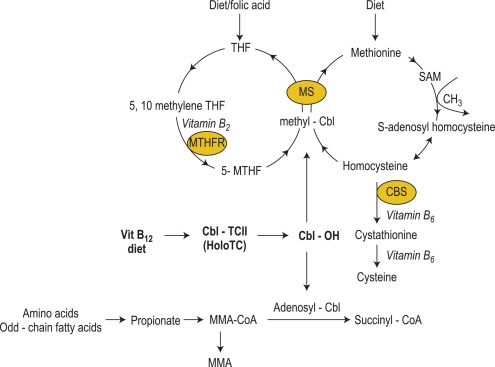
With the exception of those who consume a restricted diet (e.g. vegans and vegetarians), dietary intake of vitamin B 12 greatly exceeds metabolic requirement. The typical Western diet contains ≈ 4–6 μg/day of the vitamin, of which 1–5 μg is absorbed. Although the bioavailability of vitamin B 12 is considered high, uptake from a single serving decreases drastically once the 1.5–2.5 μg capacity of ileal receptors for the vitamin has been exceeded. A second dose of vitamin B 12 given 4–6 h later is once again absorbed with maximum efficacy. Body stores typically contain 1–5 mg of vitamin B 12 so that deficiency states may not develop until several years after the metabolic requirement has consistently exceeded dietary vitamin B 12 intake and absorption.
Vitamin B 12 deficiency is relatively common, with significant and variable clinical sequelae. , Causes of deficiency are shown in Table 10-1 . Estimates of the prevalence of vitamin B 12 deficiency are dependent on the criteria used to define a deficient state. Using serum vitamin B 12 of 200 pmol/l as a diagnostic cut-off, 3.9% of subjects over 60 years of age in the 2001–2004 National Health and Nutrition Examination Survey in the USA were defined as deficient. Prevalence varied by ethnic group with 4.1, 2.0 and 1.7% of non-Hispanic white, non-Hispanic black and Mexican Americans respectively being defined as deficient. Using serum vitamin B 12 < 147 pmol/l and homocysteine > 20 μmol/l, the prevalence of vitamin B 12 deficiency was ≈ 5% in people 65–74 years of age, and more than 10% in people 75 years of age or older. Using holotranscobalamin (HoloTC) and methylmalonic acid in tandem, 11% of a hospital patient population in the UK were defined as deficient.
| Defect | Cause | Supportive Information/Diagnostic Tests |
|---|---|---|
| Decreased intake | Malnutrition Reduced intake of animal products Strict vegan diet Breastfed babies of mothers who are vegetarian or B 12 deficient Poor dietary intake in elderly | Dietary history Ethnic origin/culture |
| Impaired gastric absorption | Atrophic gastritis with achlorhydria Gastrectomy – partial or total Zollinger–Ellison syndrome | Endoscopic and gastric biopsy findings History of gastric surgery Multiple gastric and duodenal ulcers Pancreatic adenoma on imaging |
| Addisonian pernicious anaemia | Diagnostic criteria for pernicious anaemia (see Table 10-4 ) | |
| Failure of trypsin release of B 12 from R binding proteins | Pancreatic insufficiency | Pancreatic function tests; exocrine pancreatic dysfunction results in reduced absorption but clinical deficiency is rare |
| Impaired intestinal absorption as a result of failure of B 12 -intrinsic factor complex uptake in ileum | Ileal resection or disease e.g. Crohn disease Inflammatory bowel disease and tuberculous ileitis Tropical sprue Luminal disturbances: chronic pancreatic disease and gastrinoma Parasites: giardiasis, bacterial overgrowth and fish tapeworm Blind loop syndrome | Radiological, enteroscopic or capsule camera study of small bowel for Crohn disease of terminal ileum or tuberculous ileitis Small bowel biopsy Radiolabelled lactose breath tests for bacterial overgrowth. Absorption returns to normal after antibiotic therapy |
| Congenital/inherited | Intrinsic factor receptor deficiency/defect Imerslund–Gräsback syndrome Congenital deficiency of intrinsic factor – ‘juvenile’ pernicious anaemia Inborn errors of cobalamin metabolism | Subjects of Scandinavian origin Serum and urinary methylmalonic acid and metabolite measurement |
| Abnormal transport proteins | Haptocorrin deficiency Transcobalamin deficiency Possible fall in holotranscobalamin levels in elderly | No evidence of clinical deficiency but low serum cobalamin levelsMegaloblastic anaemia in presence of normal cobalamin levels; transcobalamin and holotranscobalamin levels reduced |
| Excess consumption | Haemolysis HIV infection | |
| Acquired drug effects | Alcohol: impedes absorption as consequence of gastritis Nitrous oxide: irreversibly binds to cobalt atom in B 12 and deactivates it Proton pump inhibitors: reduce gastric acid production H 2 receptor antagonists: reduce gastric acid production Metformin: impedes absorption Colchicine: reduces IF-B 12 receptors Slow K: impedes absorption Cholestyramine: decreases gastric absorption | Chronic repeated exposure |
An overview of the steps involved in the absorption of vitamin B 12 is shown in Figure 10-2 . Ingested cobalamin is released from food proteins by pepsin and gastric acid. Two proteins then compete for the free cobalamin: a glycoprotein named intrinsic factor, which is made in gastric parietal cells, and haptocorrin (previously known as transcobalamin I and also referred to as R binder), which is produced by salivary glands. At acidic pH, intrinsic factor (IF) has a very low affinity whilst haptocorrin has a high affinity for vitamin B 12 . Thus vitamin B 12 binds to haptocorrin in the stomach. Haptocorrin primarily serves to protect vitamin B 12 from acid degradation in the stomach by producing a haptocorrin–vitamin B 12 complex. Metabolically inert cobinamides (an intermediate in porphyrin and chlorophyll metabolism) that are present in the diet are also bound. As the contents of the stomach enter the first part of the duodenum a relatively alkaline environment is encountered. The haptocorrin is partly digested by proteases secreted by the pancreas, which frees the vitamin, permitting it to attach to IF. The intrinsic factor–cobalamin complex attaches to cubam receptors, which consist of amnionless and cubilin, and the complex is taken up by endocytosis into the ileal cell. After internalisation, vitamin B 12 is freed and transported into the blood, possibly by an adenosine triphosphate (ATP)-dependent carrier, where it meets transcobalamin (previously known as transcobalamin II) and haptocorrin. Unsaturated transcobalamin is more abundant so most newly absorbed vitamin B 12 binds to it. Transcobalamin has a rapid turnover and is responsible for the daily transport of ≈ 4 nmol of vitamin B 12 into cells. Haptocorrin is almost fully saturated with vitamin B 12 (and inactive vitamin B 12 analogues) and carries the major part of the vitamin in the circulation. The metabolism of this protein, which attaches to cell surface receptors on liver and other storage cells, is slow, with a turnover of 0.1 nmol of vitamin B 12 daily.
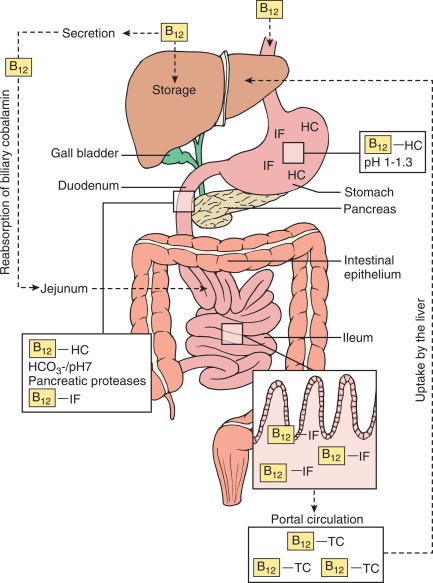
There are receptors for holotranscobalamin (TC receptors) on the surface of every DNA-synthesising cell in the human body. At the cellular level in the target tissue, HoloTC undergoes endocytosis via the transmembrane TC receptor before lysosomal degradation, releasing cobalamin for metabolic reactions.
Cobalamin undergoes enterohepatic circulation via the liver and bile ducts with 1.4 μg/day excreted in the bile, of which 1 μg/day is reabsorbed in the ileum.
Folate absorption and metabolism
Folate is a generic term that refers to a group of water-soluble vitamins that function as cofactors by carrying and chemically activating single carbons to support biosynthetic pathways. Causes of folate deficiency are shown in Table 10-2 .
| Defect | Supportive Information/Diagnostic Tests |
|---|---|
| Reduced intake | |
| Poor diet, particularly alcoholics (wine and spirits because beer contains folate) Elderly or students (‘tea and toast diet’) Dietary fads Premature babies Unsupplemented parenteral nutrition | Dietary and alcohol history |
| Malabsorption | |
|---|---|
| Coeliac disease (often with coexisting iron deficiency) Tropical sprue Small bowel resection, malabsorption syndromes | Anti-endomysial, antigliadin tests, antitissue transglutaminase Small bowel biopsy |
| Drug effects | |
| Sulphasalazine, methotrexate, trimethoprim-sulphamethoxazole, pyrimethamine, phenytoin, sodium valproate, oral contraceptives | Drug history Bone marrow aspiration |
| Hereditary hyperhomocysteinaemia | |
| Homozygotes for C677T MTHFR may have lower total folate levels and/or proportionally lower availability of 5-methyl THF | |
| Increased folate turnover | |
| Pregnancy: progressive increase in requirement in third trimester Increased requirements for breastfeeding Skin disease – severe psoriasis or exfoliation Haemodialysis Haemolysis: haemoglobinopathy, paroxysmal nocturnal haemoglobinuria, autoimmune haemolytic anaemia (see Chapter 11 , Chapter 12 , Chapter 13 ) | |
Folate polyglutamates are thermolabile and found in fruits and vegetables, in particular in leafy green vegetables. Before absorption can take place, dietary folate polyglutamates must be hydrolysed to monoglutamates by hydrolases, operating maximally at pH 5.5 in the presence of zinc and then rapidly converted to polyglutamates in cells. Folate carriers transport polyglutamates rapidly into the luminal cells where they are methylated using methylcobalamin as a cofactor and reduced to 5-methyltetrahydrofolate (5-methyl THF) in the enterocyte before entering the portal venous system. Unconverted polyglutamates remain in the luminal cells.
There is significant enterohepatic recirculation of folate, amounting to 90 μg/day. Biliary drainage results in a rapid fall in serum folate levels, whereas deprivation of dietary folate takes up to 3 weeks to cause a decrease in serum levels. Two-thirds of plasma folate is non-specifically bound to plasma folate-binding proteins including albumin, and one third circulates as free folate.
There is sufficient retention of folate by the renal tubules to prevent urinary folate loss; this is achieved by megalin uptake of filtered folate-binding protein and the bound folate. Cubam, which binds intrinsic factor-cobalamin complex, is also important in the uptake of albumin from the renal tubules, which may also contribute to folate retention.
Folate transport into cells is dependent upon two mechanisms: reduced folate carrier (58 kDa), which is a low-affinity high-capacity system; and reduced folate receptors (44 kDa), of which there are three isoforms – alpha and beta are attached to the cell surface through a glycosyl-phosphatidylinositol anchor and gamma is secreted by enteric mucosal cells. Methyltetrahydrofolate bound to the folate receptor undergoes endocytosis by clathrin-coated pits or caveolae. Passive diffusion is an alternative mechanism by which folate can enter cells. The relative contributions of the different mechanisms are not known. Folate receptors may be expressed on malignant cells and have become potential targets for delivery of cytotoxic agents linked to folate.
Folates participate in 1-carbon metabolism and thereby facilitate the essential cellular metabolism of methionine, serine, glycine, choline and histidine in the biosynthesis of purine and deoxythymidine monophosphate (dTMP) in the synthesis of pyrimidines and thus DNA ( Fig. 10-1 ).
Intracellular folates are compartmentalised between the cytosol and mitochondria, and the major forms are tetrahydrofolate (THF), 5-methyl THF and 10-formyl THF. Homocysteine is converted to methionine by methionine synthase using methylcobalamin as a cofactor and 5-methyl THF as the methyl group donor. Cobalamin deficiency therefore results in inactivation of methionine synthase, leading to an accumulation of 5-methyl THF, which cannot be converted back to 5,10-methylene THF. Folate is then unavailable for pyrimidine and purine synthesis – this is known as the methyl-trap hypothesis, which was advanced to explain why cobalamin deficiency often results in a functional folate deficiency. Furthermore, 5-methyl THF is a very poor substrate for the enzyme responsible for folate polyglutamation, folylpoly-γ-glutamate synthetase, which prefers THF and 10-formyl THF. Folate deficiency is thought to cause megaloblastic anaemia by inhibiting the production of 5,10-methylene THF polyglutamate, which acts as a cofactor in the rate-limiting step in the production of DNA, the synthesis of dTMP. Thus, in the absence of cobalamin, polyglutamate synthesis ceases and monoglutamate forms are not retained by cells. This explains why, in cobalamin deficiency, serum folate levels may be found to be elevated and red cell folate levels normal or low.
Haematological features of megaloblastic anaemia
Macrocytosis is the most common reason that vitamin B 12 status is investigated. Megaloblastic anaemia resulting from impaired DNA synthesis is characterised by the presence of megaloblastic red cell precursors in the bone marrow and occasionally also in the blood. Megaloblasts have a characteristic chromatin pattern ( Fig. 10-3 ) and increased cytoplasm as a result of asynchrony of nuclear and cytoplasmic maturation with a relatively immature nucleus for the degree of cytoplasmic haemoglobinisation. A delay in nuclear maturation caused by impaired DNA synthesis resulting from a lack of vitamin B 12 or folate is seen in all lineages, particularly granulocytic marrow precursors with giant metamyelocytes ( Fig. 10-4 ) and hyperlobated neutrophils with increased lobe size as well as an increased number of nuclear segments (see Fig. 5-10 ). In severe pernicious anaemia, a mean red cell volume (MCV) up to 130 fl occurs, with oval macrocytes, poikilocytes and hypersegmentation of neutrophils (> 5% with at least five nuclear lobes). The neutrophil hypersegmentation index is an equivalent automated parameter on some cell counters. The mean platelet volume is decreased, and there is increased platelet anisocytosis, as detected by the platelet distribution width (PDW). The MCV falls to 110–120 fl or even lower as megaloblastic change advances, as a result of the appearance of red cell fragments and small poikilocytes. Howell–Jolly bodies and basophilic stippling may be seen in the red cells.

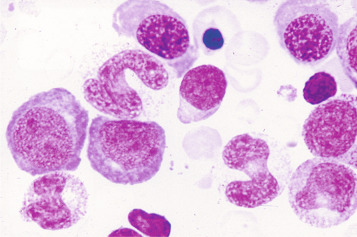
Differential diagnosis of macrocytic anaemia
Macrocytic red cells are also seen in myelodysplastic syndromes and myelodysplastic/myeloproliferative neoplasms, which can be suspected from the presence of hypogranular neutrophils (see Fig. 5-76 ) or monocytosis. Excess alcohol consumption results in an increased MCV with round macrocytes, although rarely does the MCV exceed 110 fl unless coexisting folate deficiency is present. Hypothyroidism, liver disease, aplastic anaemia and the rare inherited orotic aciduria and Lesch–Nyhan syndromes also have a high MCV. Automated reticulocyte counts facilitate detection of increased red cell turnover and high MCV as a result of haemolysis or bleeding. Coexisting iron deficiency or thalassaemia trait may mask macrocytic changes, although a high red cell distribution width indicates anisocytosis and the need for blood film review. Congenital dyserythropoietic anaemias types I and III and erythroleukaemia exhibit some features of megaloblastic erythropoiesis that are unrelated to vitamin B 12 and folate. Drugs interfering with DNA synthesis result in macrocytosis and megaloblastic erythropoiesis ( Tables 10-1 and 10-2 ).
Metabolic insufficiency
No international consensus view on what constitutes vitamin B 12 deficiency has been reached, partly because harmonised laboratory diagnostic standards have yet to be defined. However, it is clear that the investigation of vitamin B 12 and folate status must not be restricted to individuals with classic features of megaloblastic anaemia because neuropathy, optic atrophy and ≈ 20% of neuropsychiatric changes occur in the absence of macrocytosis or anaemia. , Metabolic evidence of insufficiency states (i.e. elevations in homocysteine and methylmalonic acid concentration) are frequently identified in the laboratory without clinical signs or symptoms.
Currently ≈ 75 countries require fortification of wheat flour produced in industrial mills with folic acid. In the USA and Canada, dietary supplementation with folate was introduced in 1998 to reduce neural tube defects. Subsequent follow-up showed a 25–46% reduction in the incidence of neural tube defects.
Folate and/or vitamin B 12 insufficiency causes an elevated circulatory concentration of homocysteine as a result of reduction in methionine synthesis ( Fig. 10-1 ). Homocysteine is an independent risk factor for vascular disease , and is also associated with an increased risk of venous thrombosis. , Lowering homocysteine levels may reduce the incidence of myocardial infarction and stroke.
Testing strategy for suspected cobalamin or folate deficiency
The application of a suitable testing strategy for patients suspected of having cobalamin or folate deficiency is shown in Tables 10-3 and 10-4 . Table 10-3 lists the important laboratory investigations that should be performed. Table 10-4 provides a list of clinical and laboratory features for the diagnosis of pernicious anaemia. Table 10-5 highlights the important clinical details that should be elicited by the clinician and submitted with the request to assist the laboratory in interpretation.
| Diagnostic Tests | Diagnostic Features Suggestive of Cobalamin or Folate Abnormality | Will Help to Exclude | Pitfalls |
|---|---|---|---|
| Full blood count | Macrocytosis | – | Macrocytosis and anaemia may be absent despite neuropathy |
| Blood film | Oval macrocytes, hypersegmented neutrophils (> 5% with ≥ 5 lobes); Howell–Jolly bodies suggests hyposplenism and therefore coeliac disease as a cause of the deficiency | Myelodysplastic syndromes (hypogranular or hypolobulated neutrophils, dimorphic red cells), alcohol excess/liver disease (round macrocytes, target cells, stomatocytes), haemolytic anaemia (see Chapter 5 ) | Hypersegmented neutrophils are not invariably present; they can also occur during cytotoxic therapy |
| Reticulocyte count | Absolute count low pretreatment | Reticulocyte response at day 6 post-therapy confirms response to B 12 or folate therapy provided only low dose is given | Reticulocyte response may be blunted if inadequate iron stores |
| Bone marrow aspirate (including Perls stain) before treatment or within 24 h of cobalamin or folate therapy – indicated if severe, unexplained macrocytic anaemia | Megaloblastic erythropoiesis, giant metamyelocytes, hypersegmented neutrophils, ring sideroblasts infrequent | Myelodysplastic syndromes, aplastic anaemia | Megaloblastic change is not necessarily a result of deficiency; can be drug induced or a feature of a myelodysplastic syndrome |
| Serum B 12 | B 12 < 180 ng/l suggestive of cobalamin deficiency, may be a result of pernicious anaemia, veganism or gastrectomy; in the absence of these causes, may result from malabsorption of protein-bound B 12 (e.g. as a result of achlorhydria) B 12 < 150 ng/l highly suggestive of cobalamin deficiency | B 12 < 180 ng/l with no clinical signs or symptoms and normal MMA and homocysteine reflects poor specificity of total B 12 assay. B 12 levels may be borderline low due to severe folate deficiency; give folic acid and monitor B 12 level unless neurological abnormalities present | B 12 > 180 ng/l but presence of neuropathy or strong clinical suspicion of B 12 deficiency requires a therapeutic trial or additional tests, such as MMA, holotranscobalamin and homocysteine: if holotranscobalamin is low then treat with B 12 and monitor response by repeat metabolite levels at day 6; B 12 deficiency is confirmed by high MMA and homocysteine that fall on treatment |
| Serum folate | Low level, particularly if red cell folate also low confirms deficient state | Subject to diurnal variation. Low levels may result from recent deterioration in diet. Conversely low serum folate levels are rapidly corrected by improved diet. | |
| Red cell folate | Low level, particularly if B 12 deficiency is excluded | Low red cell folate and high serum folate occur in cobalamin deficiency – treat with B 12 | |
| Serum holotranscobalamin | Early marker of B 12 deficiency. Holotranscobalamin < 25 pmol/l highly suggestive of cobalamin deficiency. Often as low as 5 pmol/l in pernicious anaemia. | Holotranscobalamin 25–50 pmol/l suggests measure MMA (or homocysteine if MMA not available). | Subject to recent dietary change (within 24h). Particularly useful in pregnancy, where levels unaffected by trimester. |
| Elevation of serum holotranscobalamin levels at 24-48 h from baseline in response to oral 9 μg cyanocobalamin 6 hourly × 3 doses | Subjects with dietary deficiency show rapid elevation of HoloTC by > 10 pmol/l or > 22% increase from baseline. Pernicious anaemia shows enhanced holotranscobalamin levels after addition of oral recombinant intrinsic factor. | ||
| Intrinsic factor antibody test (test if serum B 12 is < 150 ng/l) | Positive in 50–60% of cases of pernicious anaemia and, when positive, obviates a B 12 absorption test | False positive (rare). Negative in 40–50% of cases of pernicious anaemia; if negative, proceed to B 12 absorption test | |
| Schilling test (part I, basic test; part II, with intrinsic factor; part III, following course of antibiotics; part IV, pancreatic enzymes taken for 3 days) | Part I < 5% and part II normal or near normal confirms malabsorption as a result of lack of intrinsic factor (e.g. pernicious anaemia). Parts I and II abnormal suggests malabsorption not resulting from intrinsic factor deficiency. * Part III abnormal indicates abnormal bacterial grown. Part IV abnormal indicates pancreatic insufficiency. | Reagents not currently available. Awaiting recombinant intrinsic factor supplier. Invalid in renal failure; Part II may not correct in pernicious anaemia if intrinsic factor antibodies are present at high concentration in gastric juice | |
| Upper gastrointestinal endoscopy and duodenal biopsy † | Villous atrophy in coeliac disease. Coeliac disease indicated by positive serological tests for endomysial antibodies (EMA) and tissue transglutaminase antibodies (tTGA) | ||
| Serum gastrin or gastric juice pH | Raised serum gastrin or gastric juice pH of > 6 confirms achlorhydria: if not present, diagnosis of pernicious anaemia is suspect | ||
| Serum MMA and plasma or serum homocysteine, before treatment or before and 6 days after treatment ‡ | Raised homocysteine in folate and B 12 deficiency; raised MMA in B 12 deficiency, which is helpful to confirm deficiency if B 12 is low and IF antibodies are absent. Correction of elevated metabolite levels after cobalamin therapy provides evidence of biochemical response. | Lack of significance of low B 12 is indicated by normal MMA and homocysteine and no clinical signs. Note serum homocysteine requires sample taken on ice and separated before any haemolysis. Alternatively serum can be collected into Kabevette sample collection tubes (www.kabe-labortechnik.de) and separated within 36 hrs. | Both MMA and homocysteine are elevated in renal impairment. MMA is often elevated in the elderly and cannot be used in isolation without either B 12 or HoloTC measurement. Homocysteine is not specific for cobalamin deficiency, being elevated in folate deficiency, in smokers and in hyperhomocysteinaemia. |
* If Part II fails to correct, proceed to barium follow-through or small bowel enema to diagnose ileal disease (e.g. Crohn disease); Parts I and II abnormal, Part III normal indicates malabsorption resulting from bacterial overgrowth (e.g. blind loop syndrome).
† Upper gastrointestinal tract endoscopy is also useful if dyspepsia develops in known pernicious anaemia, to exclude gastric carcinoma.
‡ Plasma homocysteine assay is now widely available; in suspected B 12 deficiency it provides a useful test of biochemical cobalamin deficiency. Correction of elevated levels after treatment provides confirmation of deficiency.
| Laboratory Criteria | Clinical Criteria | |
|---|---|---|
| Minor criteria | Macrocytosis, anaemia Raised plasma homocysteine Gastric pH > 6 Raised serum gastrin Positive gastric parietal cell antibody | Parasthesiae, numbness or ataxia Hypothyroidism Vitiligo Family history of pernicious anaemia or hypothyroidism |
| Major criteria | Low serum B 12 (< 180 ng/l) or raised serum methylmalonic acid (> 0.75 μmol/l) in presence of normal renal function Megaloblastic anaemia not resulting from folate deficiency Positive intrinsic factor antibodies using high-specificity test Holotranscobalamin level < 25 pmol/l | |
| Reference standard criteria | Schilling test * shows malabsorption of oral cyanocobalamin corrected by co-administration of intrinsic factor |
* Reagents for Schilling tests currently unavailable. A nonisotopic B 12 absorption test has been reported.
| Symptoms or Signs | Possible Significance |
|---|---|
| Tiredness, palpitations, pallor | Anaemia |
| Slight jaundice | Ineffective erythropoiesis |
| Neurological | |
| Cognitive impairment, optic atrophy, loss of vibration sense, joint position sense; plantar responses normal or abnormal; tendon reflexes depressed or increased | Cobalamin deficiency, subacute combined degeneration of the spinal cord and optic/sensory/motor peripheral neuropathies |
| Dietary and Gastrointestinal History | |
| Vegetarian or vegan; poor nutrition (e.g. ‘tea and toast diet’ in elderly or students); dietary fads Weight loss, bloating and steatorrhoea, particularly nocturnal bowel movements Mouth ulcers, abdominal pain, perianal ulcers, fistulae Glossitis, angular cheilosis and koilonychia Alcohol history | Low iron stores and iron deficiency Cobalamin deficiency in babies born to mothers who are vegans Folate deficiency (often with iron deficiency) Features of malabsorption and folate deficiency, e.g. due to coeliac disease, tropical sprue Terminal ileal Crohn disease – cobalamin deficiency Cobalamin and combined iron deficiency Poor diet and interference with folate metabolism |
| History of Autoimmune Disease in Patient or Family | |
| Hypothyroidism, pernicious anaemia or coeliac disease | Increased likelihood of pernicious anaemia or coeliac disease |
| Surgery | |
| Gastrectomy/bowel resection | Cobalamin deficiency usually develops 2 years postgastrectomy Ileal disease resulting in cobalamin deficiency Blind loop syndromes |
| Physical Appearance | |
| Grey hair, blue eyes, vitiligo | Association with pernicious anaemia |
| Pregnancy | Increased iron and folate requirements. Cobalamin levels fall by 30% in the third trimester but without tissue deficiency Holotranscobalamin levels are unaltered in late pregnancy |
| Malabsorptive Syndrome | |
| Tropical sprue, bacterial overgrowth, fish tape worm in Scandinavian countries | Combined folate and iron deficiency Cobalamin deficiency |
| Drug History | See text |
| Other Haematological Disorders | |
| Myeloproliferative neoplasms, haemolytic anaemias, leukaemias Multiple myeloma | Increased folate utilisation may result in folate deficiency Paraprotein interference with cobalamin assays resulting in falsely low cobalamin levels, which normalise on treatment of myeloma |
Stay updated, free articles. Join our Telegram channel

Full access? Get Clinical Tree



